On February 7, 2019, Representative Alexandria Ocasio-Cortez (D–NY) and Senator Ed Markey (D–MA) released their plan for a Green New Deal in a non-binding resolution. Two of the main goals of the Green New Deal are to achieve global reductions in greenhouse-gas emissions of 40 percent to 60 percent (from 2010 levels) by 2030, and net-zero emissions worldwide by 2050. The Green New Deal’s emission-reduction targets are meant to keep global temperatures 1.5 degrees Celsius above pre-industrial levels.REF
In what the resolution calls a “10-year national mobilization,” the policy proposes monumental changes to America’s electricity, transportation, manufacturing, and agricultural sectors. The resolution calls for sweeping changes to America’s economy to reduce emissions, but is devoid of specific details as to how to do so. Although the Green New Deal also calls for universal health care, guaranteed jobs with a family sustaining wage, “healthy food security,”REF and efficiency spending on all homes and buildings, the analysis in this Backgrounder focuses on the Green New Deal’s energy-related policies, intended to reduce greenhouse-gas emissions.
To provide a broad estimate of the costs, Heritage Foundation analysts modeled the economic impact of an entire series of economy-wide carbon taxes, each increasing the tax gradually over time. We also included regulations and mandates to achieve the Green New Deal’s goal of increased renewable energy generation. Our cost estimates constitute a significant underestimate of the true costs of the Green New Deal as the carbon tax and regulations do not completely achieve the policy objectives outlined in the non-binding resolution. Furthermore, the analysis does not account for the direct taxpayer costs, as advocates want to pay for the Green New Deal through a massive stimulus-style package. Layers of additional regulations and mandates, such as the proposal’s objective to maximize energy efficiency for every new and existing building in the U.S., would drive costs even higher. Still, this analysis demonstrates how economically damaging the energy components of the Green New Deal would be for American families and businesses—all for no meaningful impact on the climate.
What Is the Green New Deal?
The Green New Deal is much more than just an energy and climate policy; it is a plan to fundamentally restructure the American economy. As stated in the non-binding resolution, “climate change, pollution, and environmental destruction have exacerbated systemic racial, regional, social, environmental, and economic injustices.”REF To correct those alleged injustices, the plan aims to change how people consume energy, develop crops, construct homes, and produce and transport goods. In other words, the government would use taxes and regulations to control actions and choices made by everyday Americans. Some of the plan’s top-line energy goals are to:
- Derive 100 percent of America’s electricity from “clean, renewable, and zero-emission” energy sources;REF
- Eliminate greenhouse gas emissions from manufacturing, agricultural, and other industrial sectors to the extent it is technologically feasible;
- Spend massively on clean-energy manufacturing and renewable-energy manufacturing;
- Eliminate greenhouse gas emissions from transportation and other infrastructure as much as technologically feasible, by (among other means) increased government spending on clean infrastructure and high-speed rail;REF and
- Maximize efficiency for every single new and existing residential and industrial building.
What Would a Green New Deal Cost Americans?
Credibly estimating the cost of the Green New Deal’s energy policies for American taxpayers, households, and businesses is an exceedingly complex task. The resolution does not specify requiring the grid to transition to 100 percent renewables, and instead stipulates “100 percent clean, renewable, and zero-emission” energy sources. How companies would make large-scale investments to meet the mandate and how intermittent power sources would receive backup power is purely speculation and guesswork. Even projecting the cost of switching to 100 percent renewable power for electricity relies on a set of largely unknowable and untestable assumptions. The costs of stranded assets and lost shareholder value and the cost to taxpayers could easily surpass $5 trillion.REF Without specific legislative detail, assessing the public and private costs is extremely difficult.
To estimate the economic impact of a Green New Deal, we used the Heritage Energy Model (HEM), a clone of the U.S. Energy Information Administration’s National Energy Model. As mentioned on Representative’s Cortez’s website, the carbon tax constitutes only one of many policy measures that Green New Deal advocates hope to implement.REF As a result, we implemented an economy-wide carbon tax (phased in over two years and increasing by 2.5 percent each year thereafter), a series of regulations on the manufacturing industry encouraging use of fewer carbon-emitting sources of energy, and mandates for more renewable energy, which currently provides 17 percent of America’s electricity needs.REF Further details of our modeling are described in the appendix.
As the policy’s stated goal is to reduce carbon-dioxide (CO2) emissions to zero by the middle of the century, the first step in our analysis was to ascertain HEM’s capabilities of doing so. In particular, we ran a series of simulations with the mandates and regulations described above, gradually increasing the level of the carbon tax. Chart 1 illustrates the levels of CO2 abatement estimated by the model in the middle of the century.
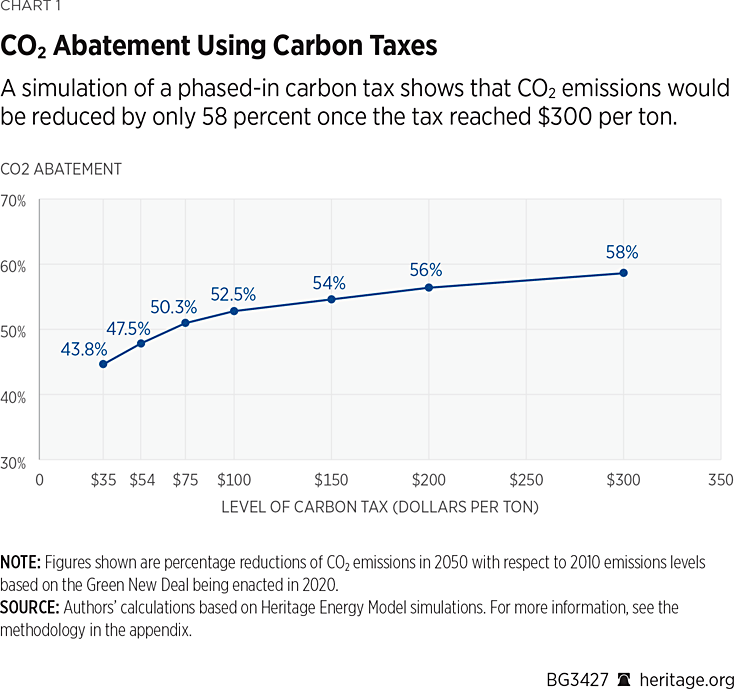
As seen in Chart 1, HEM predicts that reducing higher and higher amounts of carbon will not be as simple as instituting higher taxes. Specifically, as the taxes were incrementally increased, the marginal reduction in emissions shrank. In our simulations, a $35 carbon tax results in a 44 percent reduction in CO2 emissions by 2050, a $100 carbon tax results in a 53 percent reduction, a $200 tax results in a 56 percent reduction, and a $300 tax results in a 58 percent reduction from 2010 levels. Carbon taxes above $300 (resulting in slightly above 50 percent CO2 reductions by 2050) cause the model to crash, and thus a 58 percent CO2 reduction from 2010 levels is the largest level we are able to model.
As a result of the $300 carbon tax, coupled with the regulations and mandates described in the appendix, our simulations find that by 2040, the country will incur:
- An overall average shortfall of over 1.1 million jobs;
- A peak employment shortfall of over 5.2 million jobs;
- A total income loss of more than $165,000 for a family of four;
- An aggregate gross domestic product loss of over $15 trillion; and
- Increases in household electricity expenditures averaging 30 percent.
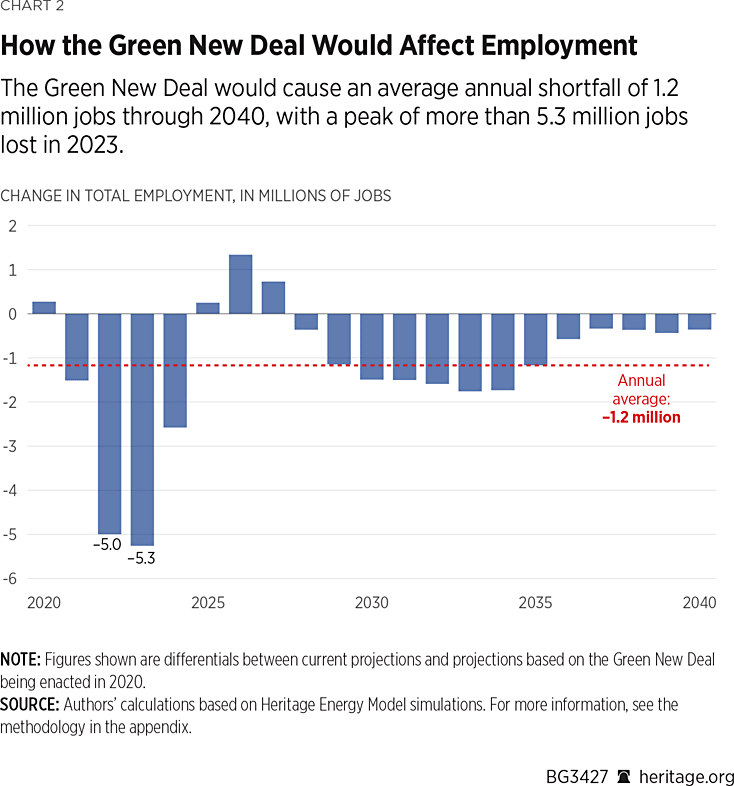
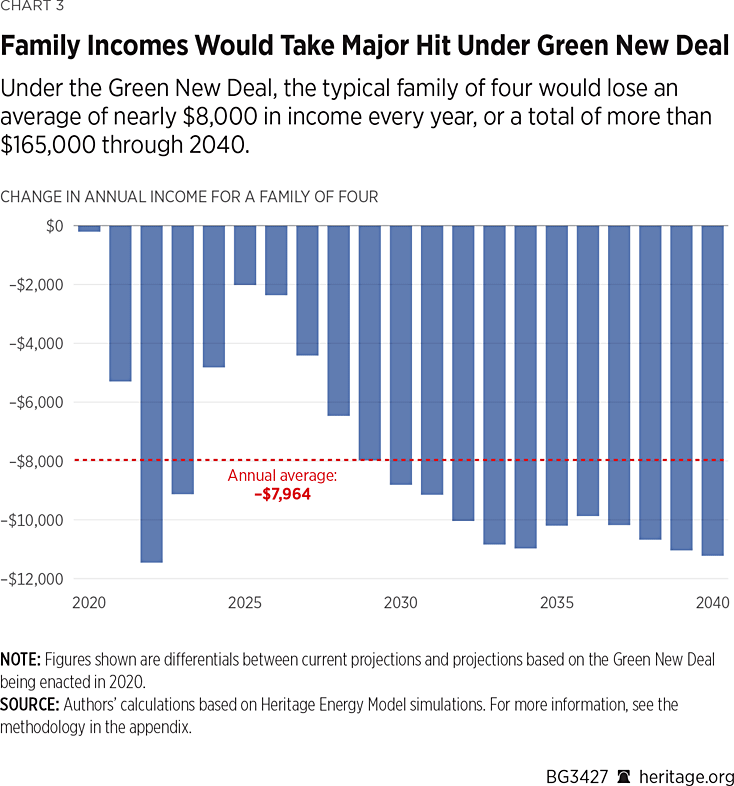
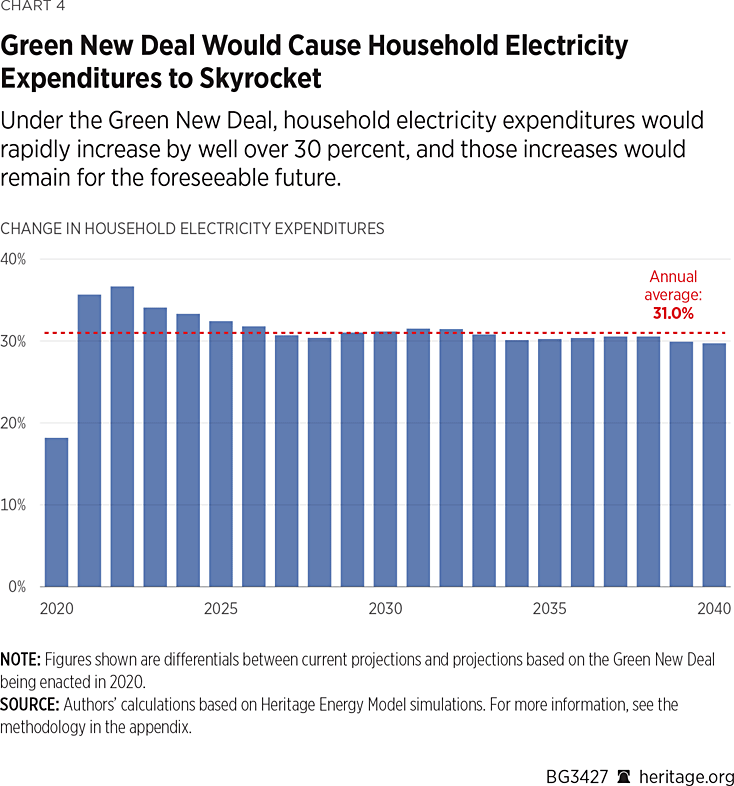
Chart 5 depicts a sector by sector analysis of the impact.
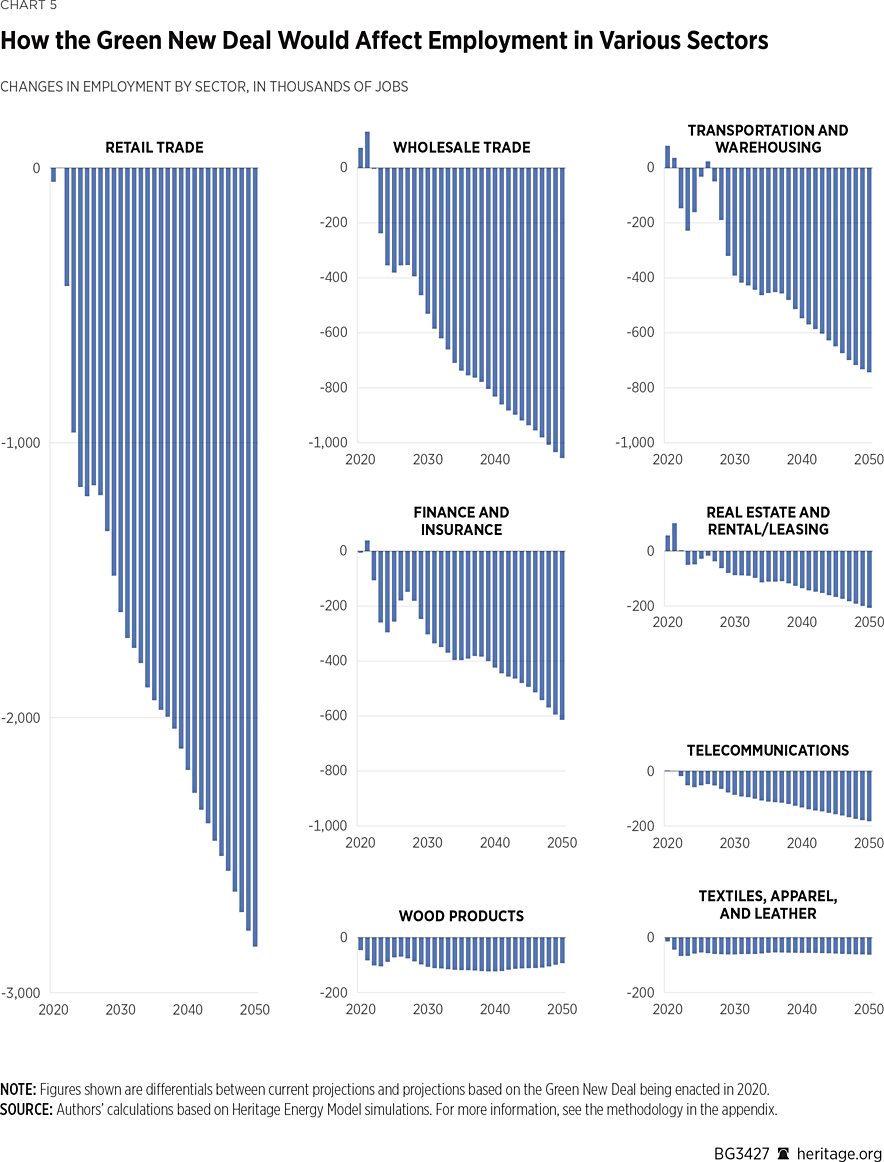
Unquestionably, as the policy only results in 58 percent CO2 emissions reductions, these estimates significantly underestimate the costs of the Green New Deal. If policymakers spent, taxed, and regulated energy to truly achieve greenhouse-gas-free emission levels, the costs would almost surely be several orders of magnitude higher. And, more fundamentally, the policies proposed in the Green New Deal are highly regressive. Higher energy costs affect low-income households disproportionately, as they spend a higher percentage of their budget on energy.
What Impact Would a Green New Deal Have on Climate Warming?
No matter where one stands on the urgency to combat climate change, the Green New Deal’s policies would be ineffective in abating temperature increases and reducing sea-level rise. In fact, even if the U.S. were to cut its CO2 emissions 100 percent, it would have a negligible impact on global warming. Using the Model for the Assessment of Greenhouse Gas Induced Climate Change, we find that using a climate sensitivity (the warming effect of a doubling of CO2 emissions) larger than that assumed by the Obama Administration’s Interagency Working Group, the world would only be less than 0.2 degree Celsius cooler by the year 2100, and sea-level rise would be slowed by less than 2 centimeters.REF Chart 6 provides the results from a series of simulations of various climate sensitivities, which demonstrate the negligible climate impact of these policies.
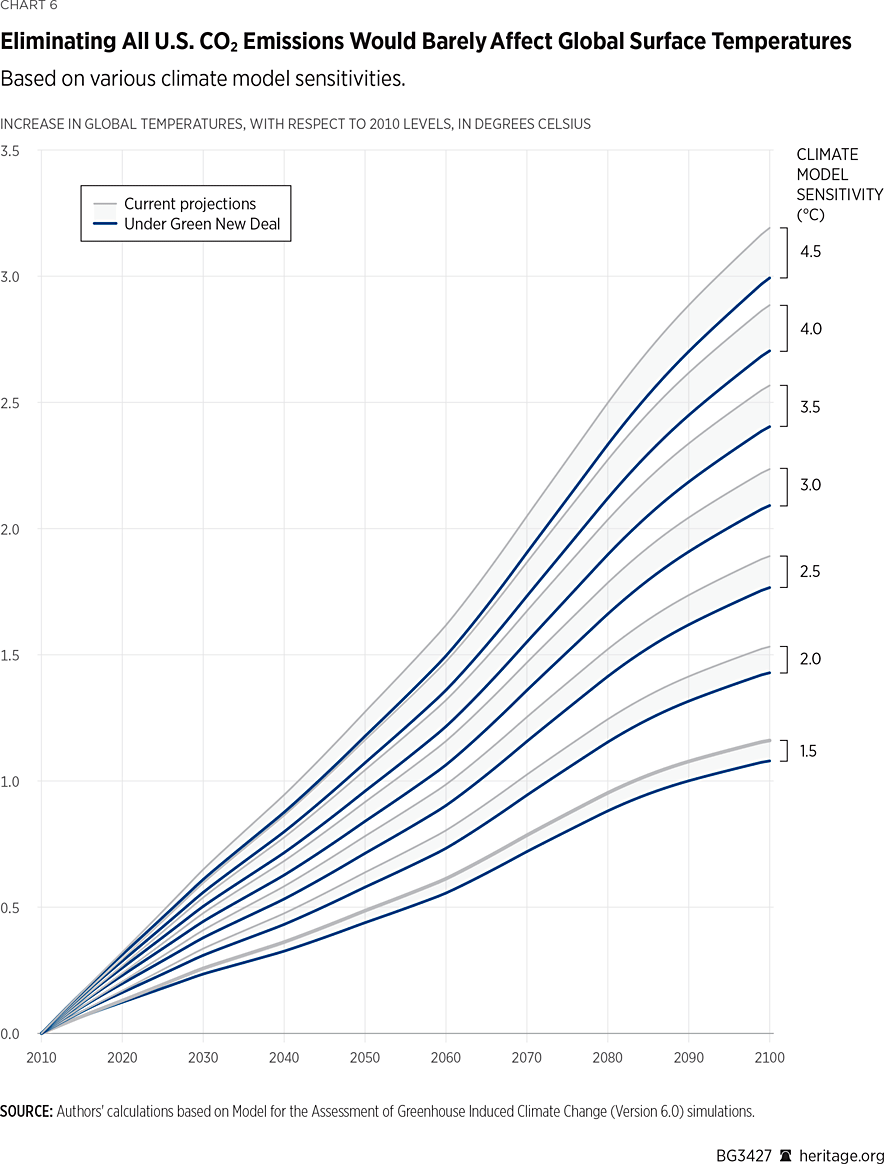
Recommendations to Drive Energy and Environmental Innovation
The Green New Deal would amount to more centralization of power in Washington where the government would determine what type of energy Americans produce and consume. Congress should prevent unelected regulators from misleading the public on the “climate benefits” of greenhouse-gas regulations. Furthermore, policymakers should put forth policy improvements that will drive innovation among all forms of energy. Breaking down barriers to competition, freeing up innovative pathways for new technologies, and freely trading energy technologies will meet America’s and the world’s energy needs while helping the environment. Specifically, Congress should:
- Require any greenhouse-gas regulation to include a separate global-temperature impact and a sea-level-rise impact. If the purpose of climate-change regulation is to slow warming, then regulators should measure the benefits through the regulation’s project impact on warming rather than aggregate emissions reduced, which mislead the public about the benefits of the policy.REF The Model for the Assessment of Greenhouse Gas Induced Climate Change provides more useful information for regulators, Congress, and the public when assessing the climate benefits of greenhouse-gas regulation.
- End the use of the social cost of carbon (SCC) in cost-benefit analyses. Congress should prohibit any agency from using regulatory analysis metrics with the SCC or the “social cost” of other greenhouse-gas emissions in any cost-benefit analysis or environmental review. As has been extensively documented in research by Heritage Foundation analysts, the statistical models on which the federal government relies to estimate the so-called social cost of greenhouse gases are highly prone to user manipulation and are thus not credible tools for policymaking.REF If federal courts force regulators into estimating the costs of climate change, they should not use SCC, but the Model for the Assessment of Greenhouse Gas Induced Climate Change, to calculate the global temperature change of regulations or new infrastructure, as has been done in this Backgrounder.
- Restate and clarify in law that the Clean Air Act was never intended to regulate greenhouse gases as air pollutants. Since conventional carbon-based fuels provide approximately 80 percent of America’s energy needs, climate-change regulations will drive electricity bills and gas prices higher. Cumulatively, they will cost hundreds of thousands of jobs and tens of thousands of dollars in lost household income and produce no discernable climate benefit.
- Fix the regulatory and policy problems facing commercial nuclear power. Facing a complex and burdensome regulatory system, commercial nuclear power in the U.S. has unnecessarily high construction costs. The regulatory system that licenses and permits nuclear reactors fails to keep up with technological innovations and overregulates existing nuclear technologies. Congress should instill regulatory discipline at the Nuclear Regulatory Commission (NRC), encourage the Environmental Protection Agency to right-size radiation-exposure standards, review foreign ownership caps, reform the NRC’s cost-recovery structure, and introduce market principles into spent-fuel management.REF
- Fix the regulatory and policy problems facing renewable energy. Like most other energy projects, renewable power projects face excessive and duplicative regulations that increase costs and cause unnecessary delays. Siting and permitting issues can be particularly problematic for wind and solar energy because the most advantageous locations for generation are in more remote areas. Congress should reform outdated environmental statutes, such as the National Environmental Policy Act and the Endangered Species Act, to create a more efficient permitting process for all energy projects, including renewables.REF
- Expand energy innovation internationally. Congress and the Trump Administration should work with other countries to open up their energy markets. These reforms should include pursuing a zero-tariff policy, engaging in technology transfer to unlock natural resources in other countries, and engaging in commercial nuclear trade that would incentivize both cooperation and competition, bringing new nuclear technologies to the market.REF
Green New Deal: More about Government Control than Climate Control
A Green New Deal would be incredibly costly for American families and businesses—all for no meaningful climate benefit. Moreover, the plan would introduce a completely new level of cronyism and corporate welfare that would harm consumers multiple times over. The policies proposed in the Green New Deal would disrupt energy markets and skew investment decisions toward politically connected projects, as has been the case with politically favored energy projects in the past.REF Instead of implementing economically destructive policies of more taxes, regulations, and subsidies, federal and state policymakers should remove government-imposed barriers to energy innovation. Allowing all forms of energy to compete equally in a free market will enable the U.S. to make tremendous strides in terms of a healthy economy as well as a healthy environment.REF
Kevin D. Dayaratna, PhD, is Senior Statistician and Research Programmer in the Center for Data Analysis, of the Institute for Economic Freedom, at The Heritage Foundation. Nicolas D. Loris is Deputy Director of, and the Herbert and Joyce Morgan Fellow in, the Thomas A. Roe Institute for Economic Policy Studies, of the Institute for Economic Freedom.
Appendix: Methodology
The Heritage Energy Model
The analysis in this Backgrounder uses the Heritage Energy Model (HEM), a clone of the National Energy Model System (NEMS) 2018 Full Release.REF NEMS is used by the Energy Information Administration (EIA) in the Department of Energy as well as various nongovernmental organizations for a variety of purposes, including forecasting the effects of energy policy changes on a plethora of leading economic indicators.
The methodologies, assumptions, conclusions, and opinions in this Backgrounder are entirely the work of statisticians and economists in the Center for Data Analysis (CDA) at The Heritage Foundation, and have not been endorsed by, and do not necessarily reflect the views of, the developers of NEMS.
HEM is based on well-established economic theory as well as historical data, and contains a variety of modules that interact with each other for long-term forecasting. In particular, HEM focuses on the interactions among
- The supply, conversion, and demand of energy in its various forms;
- American energy and the overall American economy;
- The American energy market and the world petroleum market; and
- Current production and consumption decisions as well as expectations about the future.REF
These modules are the:
- Macroeconomic Activity Module,REF
- Transportation Demand Module,
- Residential Demand Module,
- Industrial Demand Module,
- Commercial Demand Module,
- Coal Market Module,
- Electricity Market Module,
- Liquid Fuels Market Module,
- Oil and Gas Supply Module,
- Renewable Fuels Module,
- Natural Gas Market Module, and
- International Energy Activity Module.
HEM is identical to the EIA’s NEMS with the exception of the Commercial Demand Module. The Commercial Demand Module makes projections regarding commercial floor-space data of pertinent commercial buildings. Other than HEM not having this module, it is identical to the NEMS.
Overarching these modules is an Integrating Module, which consistently cycles, iteratively executing and allowing these various modules to interact with each other. Unknown variables that are related, such as a component of a particular module, are grouped together, and a pertinent subsystem of equations and inequalities corresponding to each group is solved via a variety of commonly used numerical analytic techniques, using approximate values for the other unknowns. Once a group’s values are computed, the next group is solved similarly, and the process iterates. After all group values for the current cycle are determined, the next cycle begins. At each particular cycle, a variety of pertinent statistics is obtained.REF HEM provides a number of diagnostic measures, based on differences between cycles, to indicate whether a stable solution has been achieved.
This Backgrounder uses HEM to analyze the impact of a carbon tax as well as carbon-related regulations on the economy. As illustrated in Chart 1 of this Backgrounder, we modeled $35, $54, $75, $100, $200, and $300 carbon taxes (per ton of carbon). The carbon tax begins in 2020, with half of the specified value per ton of CO2, doubles to its full value the following year, and increases annually by 2.5 percent each year thereafter. In our simulations, each consisting of four cycles, we rebated the revenue collected from the tax back to consumers in a deficit-neutral manner. We also implemented regulations on the manufacturing industry by more rapidly retiring CO2-intensive technologies as well as discouraging their use. Lastly, we required that renewable forms of energy constitute a much larger fraction of the energy portfolio than is currently the case, stipulating that at least 20 percent of renewable electric generation in 2020 come from particular renewable forms of energy and have this percentage gradually increase to 64 percent in 2050. The specific forms of renewable energy we mandated in our simulations included biomass, geothermal, wind, solar, and other forms of intermittent energy.
The Model for the Assessment of Greenhouse Gas Induced Climate Change
The analysis in this Backgrounder also uses the Model for the Assessment of Greenhouse Gas Induced Climate Change (MAGICC) versions 5.3 and 6.REF The MAGICC model quantifies the relationship between atmospheric radiative forcing, oceanic heat content, and surface temperature perturbation via the following relationship:REF
$$\Delta Q_G={\lambda_G}\Delta T_G+\frac{dH}{dt}$$
where \(\Delta Q_G\) represents the global-mean radiative forcing at the upper level of the troposphere. This extra energy influx is decomposed into increased outgoing energy flux and heat content changes in the ocean via the derivative \(\frac{dH}{dt}\). The outgoing energy flux is related to the global-mean feedback factor \(\lambda_G\) as well as surface temperature perturbation \(\Delta T_G\).
Climate sensitivity, denoted in the MAGICC model as \(\Delta T_{2x}\), is defined as the equilibrium global-mean warming after a doubling of CO2 concentrations and specified via a reciprocal relationship to a feedback factor \(\lambda\):
$$\Delta T_{2x}=\frac{\Delta Q_{2x}}{\lambda}.$$
In the above equation, \(\Delta T_{2x}\) represents the climate sensitivity and \(\Delta Q_{2x}\) represents the radiative forcing following a doubling of CO2 concentrations. The time or state-dependent effective climate sensitivity \(S^t\) is defined by combining the above two equations as follows:
$$S^t=\frac{\Delta Q_{2x}}{\lambda^t}=\Delta Q_{2x}\frac{\Delta T_G^t}{\Delta Q^t-\frac{dH}{dt}|^t}$$
where \(\Delta Q_{2x}\) represents the model-specific forcing corresponding to doubled CO2 concentration, \(\lambda_t\) represents the time-variable feedback factor, \(\Delta Q^t\) represents the radiative forcing, \(\Delta T_G^t\) represents the global-mean temperature perturbation, and \(\frac{dH}{dt}|^t\) represents the climate system’s heat uptake at time \(t\).
MAGICC also contains a carbon-cycle model that incorporates temperature-feedback effects. One of the a priori specifications pertaining to this model is a greenhouse-gas-emissions trajectory. We assumed trajectories specified in the model based on the most recent Intergovernmental Panel on Climate Change (IPCC) Assessment Reports.
We ran MAGICC simulations using the most two recent versions, 5.3 and 6. Upon modifying emissions trajectories and specifying a climate sensitivity, one can run the MAGICC model to generate these forecasts. In our simulations using MAGICC 5.3, we used and modified the A1B trajectory, specified in the IPCC’s Special Report on “Emissions Scenarios” and used in the IPCC’s “Third Assessment Report” and “Fourth Assessment Report.” In our simulations using MAGICC 6, we used and modified Representative Concentration Pathway 6.0, specified in the IPCC’s “Fifth Assessment Report.”REF
Using data from the Environmental Protection Agency, we found that the United States emitted approximately 40 percent of CO2 emissions with respect to all Organization for Economic Co-operation and Development (OECD) member nations.REF In our simulations, we altered OECD projections accordingly, assuming this fraction to be constant over time. We also assumed climate sensitivities varying between 1.5 degrees Celsius and 4.5 degrees Celsius, which encompass the range of “likely” sensitivities specified in the IPCC’s “Fifth Assessment Report.”REF The upper bound of this range is significantly higher than that assumed by the Obama Administration’s Interagency Working Group in its analysis.REF





